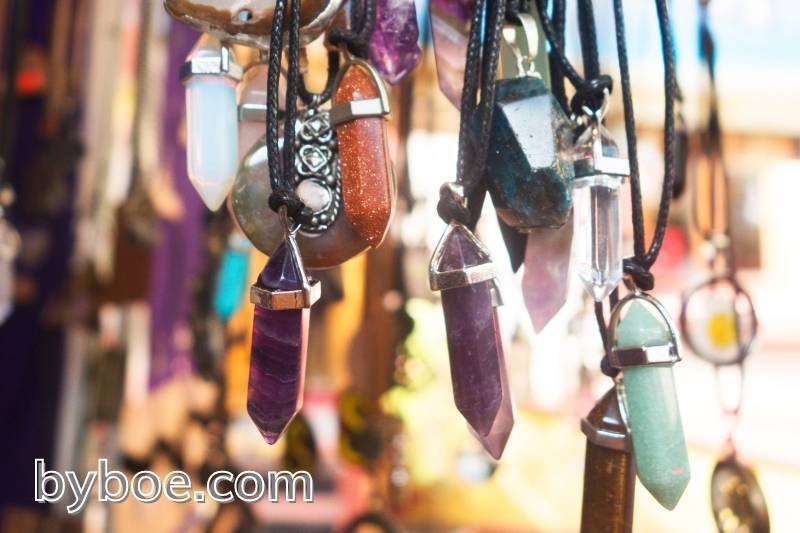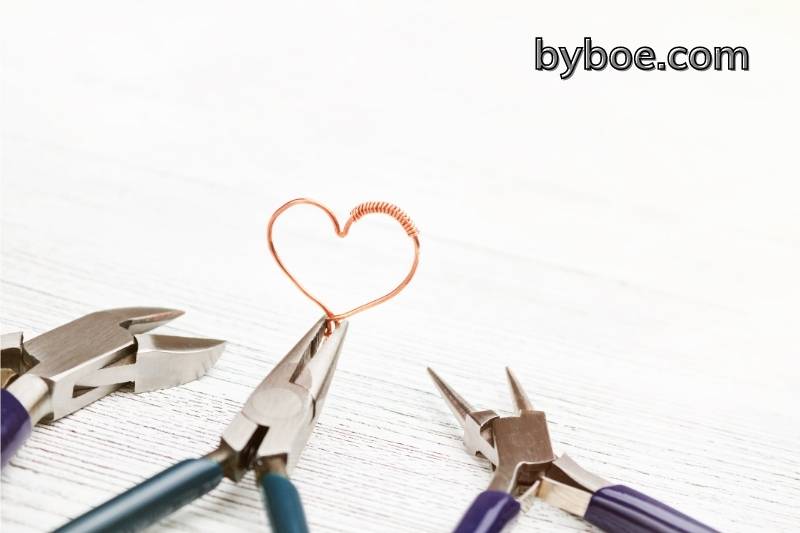Are you a natural stone collector? You want to know How To Make A Stone Necklace Without Drilling to create a unique piece. This is an amazing and brilliant idea. We have also provided some helpful information to answer your question. It is a wonderful idea to gift a necklace made from natural stone.
You will need the following items to make your pendant necklace from natural stones. Let’s get started! To make it as easy as possible for you to understand, we have made the guide as detailed and comprehensive as possible. The videos can help speed up the process of making chains.
Table of Contents
How to Make a Wire-Wrapped Stone Pendant Necklace

What you’ll need
- Equipment / Tools
- Cutters for wire
- Round nose pliers
Materials
- 24-gauge wire
- Stone or another pendant material
- Necklace chain
Instructions
1. Cut the Wire
Two pieces of 24-gauge wire should be cut at least 5 feet in length. The size of the stone will determine how much wire you need. This tutorial measures just over 1/2 inches wide by 1 in tall. You might use 22-gauge wire to make a heavier stone. It is slightly thicker.
2. Twist the Wires Together for 1 Side
Cross the wires at their centers and twist them together, as shown in the image below. To twist the wires, hold them near their intersection with your thumb and index fingers. Both wires should be twisted around each other and not wrapped around one another in a coil.
The pendant will be formed by twisting the other side. It takes some practice to get the right twist, but it is possible to create these pendants with no problems. They can be very natural and freeform.
3. Align the Wire on the Stone
Place the twisted wire on the stone’s side and then place the stone in between them (as shown in the photo below). To prevent wires from slipping out, ensure that they are placed below the stone’s wide point. To ensure that the wire is in a secure place, you might need to make side twists.
4. Twist the Wire to Form the Basket Base
Twist the wire just enough to secure the stone on the opposite side.
5. Finish the Wire Twists for the Other Side
Continue twisting the wire until it is equal in length to the other side. If the stone has uneven sides, you can adjust the length of the wire to match the length on the opposite side. Temporarily removing the stone will make it easier to create even twists.
You have now created a wire basket to hold your stone. Make sure the stone fits properly. The wire twists should be up on each side, and the stone shouldn’t slip through the base.
6. Secure the Stone
While holding the stone in place, take one end of each wire and bend them in the front and back.
7. Twist the Wires Together
To secure the stone, twist the wires on both the front and back. Twist each pair at least one inch. The pendant will be hung with the extra twist wire.
8. Secure the Wires
Wrap one of the twisted cables at a 90-degree angle and wrap it around the other wires at least twice. This will tighten the wires around your stone.
9. Trim the ends
You can trim the end that you have just twisted to a spot on either the back or side of the pendant so it is out of sight.
10. Create a wrapped loop
To create the loop at the top of your pendant, use your round-nose pliers. The twisted wire from the pendant should be wrapped around the pliers to touch the pendant.
Next, wrap the twisted steel twice around the loop at the same spot as the other length. Then trim the end so that it isn’t as obvious.
11. Adjust the Wires, and add a Chain
To ensure that the stone is secured, adjust the wires. You can tighten any wires that have become loose during wrapping. Grasp one of the single wires between your jaws and give it a twist using the pliers. This will create a slight kink in the wire that will tighten it around the stone.
Add your necklace chain through your wire loop, and then you can put on your pendant jewelry.
A Few Notes About Wire Wrap Stone Techniques
Tucking wire ends – You’ll hear me tell you “trim and tie” many times. Sharp ends shouldn’t poke through your skin or snag on your clothes. To tuck your ends into wirework or flatten them against your piece, you can use pliers.
Coiling – This is a simple way to wrap wire and to add some grounding. You can also use this technique to create a messy look. It adds a central focus and helps you organize your work. You can also work neatly with a few coils stacked against each other.
Weaving – Usually, you will weave with a thin wire that is woven around a thicker one. Because I wanted my coil thicker, I used thicker wires and let the weave hang loose. It can be a bit messy, but it adds an artistic touch to coiling.
A Few Notes About Which Wires To Use To Wire Wrap Stone
Tip: If you are new to copper jewelry making, you can view my complete tutorial!

Hardness – The most important feature of any wire is its softness. The softer wire will bend better, wrap more smoothly, and be easier to work with. They will also mark easily. This is why I recommend that you have both non-serrated and serrated nylon jaw pliers on hand for those times when your nylon jaw is too awkward.
Material – Precious metals such as copper, silver, gold, and gold-filled tend to be softer than steel, brass, or other less expensive metals. They can also be expensive. Copper is an excellent “starter wire”, as it’s soft and easy to work with but still very affordable.
Gauge – The gauge is the thickness of a wire. The thinner the wire, the higher the gauge. If you are serious about wire wrapping, I recommend that every gauge between 12-28 be available. However, this might not be feasible for beginners.
Instead, I recommend keeping 16 gauge, 20gauge, and 24gauge handy. For most projects, 20 gauge is an acceptable thickness. I used it for this wire wrap stone pendant.
FAQs
How do you wire wrap raw stones?
Instructions Twist the Wires. Hold the two wires together, find the middle, and twist them around each other. … Place Your Stone. Shape the two wires at the bottom of the twist to create a V. … Wrap and Twist Some More. … Cross and Continue. … Create a Bail.
See more: https://www.craftsy.com/post/wire-wrapped-pendant-tutorial/
What gauge wire is best for wrapping stones?
20-gauge wire The best gauge wire for wrapping stones is 20-gauge wire. A 20-gauge wire is easy to bend and wrap, but it will not break as easily either. Copper wire is the most common and the most affordable, so it is a good choice across the board.
Read also: https://www.thecreativefolk.com/best-gauge-wire-wrapping-stones/
How do you make a pendant out of stone?
One of the easiest ways to turn a stone into a pendant is by wrapping it in thin gold wire. Use a dab of E6000 to hold the end of the wire in place, and then start wrapping. Tuck the end of the wire into the grouping near the glue. Let dry for 30 minutes.
Search for: https://www.brit.co/how-to-make-gem-stone-necklace/
What wire do I use to wrap crystals?
Supplies for Making Wire-Wrapped Jewelry. Copper wire is the most common and affordable option, so it is perfect for beginners. When it comes to gauging, the lower the number, the thicker the wire. The 16-18-gauge wire is hard to bend but holds shape well. The 24-26-gauge wire bends easily but is also easy to damage.
Click here: http://blog.beadsofcambay.com/the-beginners-guide-to-wire-wrapping-stones/
Conclusion
Wrap small and large stones. It’s fine if they have slightly different shapes. This makes the jewelry more intriguing. The cord wrap pendant necklace can be made in a matter of minutes. It makes a wonderful personalized gift, especially when you choose a pendant that is meaningful to the recipient.
We are happy to answer any questions you may have about how to wrap ice. We also provide answers to many of the most frequently asked questions in the forum. We will quickly add information and check the issue as soon as we can to assist you.
Related Post:
- How To Make A Necklace 2023: Top Full Guide
- How To Untangle A Necklace 2023: Top Full Guide
- How To Clean Silver Necklace 2023: Top Full Guide

